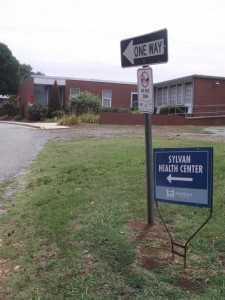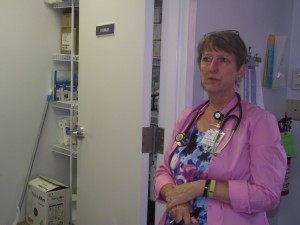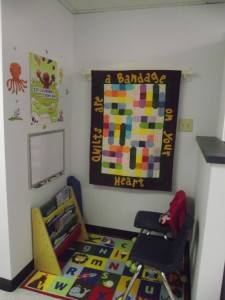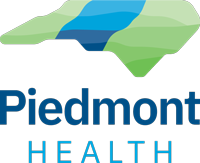Originally posted SEPTEMBER 8, 2014 on http://www.northcarolinahealthnews.org By Hyun Namkoong
The sole health care provider in the community of Snow Camp operates out of a donated trailer from Sylvan Elementary School to meet the primary health care needs of students, teachers and residents.
Cows and tobacco fields easily outnumber people in the pastoral community of Snow Camp in Alamance County. And like many rural areas in the state, access to primary health care services was a big challenge, until last year.
That’s when a partnership between the UNC-Chapel Hill School of Nursing, Piedmont Health and the Alamance-Burlington School System led to the creation of the Sylvan Community Health Center, a clinic that operates out of a donated trailer on the grounds of Sylvan Elementary School in Snow Camp.
 Signs point the way to Sylvan Health Center, tucked away on a corner of the Sylvan Elementary’s school grounds
Signs point the way to Sylvan Health Center, tucked away on a corner of the Sylvan Elementary’s school grounds
“It’s a great partnership, because the school is often the hub of a small rural community,” said Leslie Sharpe, a nurse practitioner who runs the clinic.
Tucked away on a corner of school property, signs point the way to the Sylvan Community Health Center. The center has two exam rooms, a children’s play area and a lab.
Before Sylvan Community Health Center opened up, there were no health care services in Snow Camp.
Kevin Farrell said he used to drive 30 to 35 minutes to take his kids to a large practice in Burlington, where wait times were often considerable.
“We have someone right in our community that provides good care, and knows us,” he said.
About one in six Alamance County residents live in poverty, according to the latest U.S. Census statistics, affecting their ability to get care and pay for it. The Sylvan Community Health Center provides its care on a sliding scale.
“We work with them regardless of their income,” Sharpe said.
Initially, parents and community members raised security concerns about having a clinic on school grounds; surveillance cameras and an alarm system are now in place.
“We look at the sex offender website for every patient who comes in,” Sharpe said. “We don’t do walk-ins unless you’re an established patient.”
Caring for teachers and students
Sylvan Community Health Center’s location on school property makes it easy for teachers, students and parents to get care when they need it, without missing class or work.
“It’s right there,” Gaye Sartin, principal of Sylvan Elementary exclaimed, smiling broadly. “It’s not another day off work.”
One of the primary goals of the health center is to reduce both school absences for students and time off from work for parents and teachers.
 Leslie Sharpe, stands in the laboratory space of the Sylvan Health Center where blood samples and the like are stored.
Leslie Sharpe, stands in the laboratory space of the Sylvan Health Center where blood samples and the like are stored.
Sartin said that children would be out sick from school for several days and sometimes siblings would stay home too. “It’s really impacted attendance,” she said. “Families [are] feeling better.”
Teachers don’t have a lot of time to get their health needs met because it’s not easy for them to find a substitute, Sharpe said. She’s now seen almost two-thirds of the teachers from Sylvan Elementary.
“As [teachers], we’re really quick to neglect our own health care,” Sartin said. “It’s really helped our staff stay well.”
“When a teacher comes, we work them in, even if we’re crazy,” Sharpe said.
Rural health care crisis
Limited access to health care in North Carolina’s rural areas has been in the national spotlight after Belhaven Mayor Adam O’Neal’s 237-mile walk from eastern North Carolina to Washington, D.C. to draw attention to what he and the NAACP call a “rural health care crisis.”
The landscape of health care in rural areas is unique and complex. Research shows that geographic isolation and poverty are often barriers to health care access in these communities.
 Children have a space to play in while they wait in the Sylvan Health Center.
Children have a space to play in while they wait in the Sylvan Health Center.
More than 1.5 million North Carolinians are uninsured. People who are uninsured are more likely to forgo or delay seeking health care, driving up visits to the emergency department and making health care more expensive for people who are insured.
“There are a lot of people out here who just haven’t been in health care in years,” Sharpe said.
She said that she’s diagnosed “advanced cancer” in perhaps eight or nine patients. She’s also seen many patients who have never been treated for diabetes and have glucose levels of more than four times what is considered normal. Such levels are characterized as medical emergencies.
“I am seeing a tremendous amount of newly diagnosed chronic illness,” Sharpe said.
NPs filling the gap
It can be difficult finding health care professionals who want to practice in rural areas. Sharpe said that Piedmont was having trouble filling the nurse practitioner position in the local health center.
“Not as many [providers] want to drive out here,” she said. “And you’re kind of on your own when you’re out here.”
Data show that although the state has seen an increase in primary care providers in the last 20 years, rural areas have been hit hard by provider shortages.
Increasingly, states across the country are looking to nurse practitioners to provide quality care in rural areas. Eighteen states have granted full autonomy to nurse practitioners to help fill the primary care gap. In North Carolina, nurse practitioners must practice under a collaborative agreement with a supervising physician. However, they are allowed to prescribe most medications.
Sharpe said she doesn’t have “everything” in her small exam room that’s equipped with a blood pressure cuff and a defibrillator, but that she has access to what she regularly needs.
“You don’t have to have a big health center everywhere you go,” she said. “I think there is so much potential for this.”
